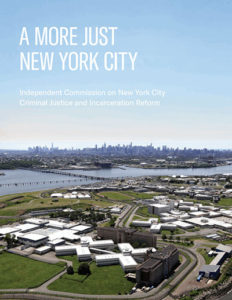Independent Commission & State Officials Back Closure of Rikers Island
NEW YORK — The Independent Commission on New York City Criminal Justice and Incarceration Reform, the body tasked with developing a recommendation as to the fate of New York City’s Rikers Island jail complex, issued a report on April 2 calling for the complex’s permanent closure. Gov. Andrew Cuomo voiced his support for the move as well, and on March 31in a change of direction from earlier statements, Mayor Bill de Blasio also got behind efforts to close the facility.

Photo Credit: Independent Commission on New York City Criminal Justice and Incarceration Reform
The report calls for halving the city’s correctional population over the next decade and constructing smaller, more modern facilities in each of the city’s five boroughs. “The commission has concluded that shuttering Rikers Island is an essential step toward building a more just New York City,” the commissions stated in the report. “Refurbishing Rikers is not enough.”
Speaking with the New York Times, City Council Speaker and commission member Melissa Mark-Viverito said: “This is a historic day. With the release of this report and the support of the mayor as announced on Friday, we can now say that the dream of closing Rikers will become a reality.”
The 27-member independent commission was convened in 2016 and has worked alongside both private and non-profit sector partners to study the criminal justice system in New York City, with a particular focus on what should be done with Rikers Island, according to the report’s introduction, authored by the Hon. Jonathan Lippman, commission chairperson. Taking into consideration comments and perspectives from a wide variety of stakeholders and conducting “independent and in depth analysis of the available data and research,” commissioners examined both the complex’s recent successes and its failures. Commission members ultimately ruled out solutions related to inmate population reduction, facility renovation and investment in new resources, noting that none would address the complex’s underlying issues.
“For more than 20 years, New York City has successfully driven down both crime and incarceration,” Lippman wrote. “The city has proven that more jail does not equal greater public safety. Indeed, an emerging body of research suggests that jail can actually make us less safe, leading to more criminal behavior and undermining the health of families and communities alike.
Another primary complaint about the Rikers Island complex is its remote location, inspiring the commission to instead recommend a smaller, borough-based jail system. Lippman and other commission members also recommended a greater emphasis on inmate rehabilitation, calling it both “the right thing to do” and “fiscally prudent”, nothing that the shift in focus is expected to yield significant cost savings and better prepare the city for future needs. Further, ending the use of Rikers Island as “a de facto penal colony” is expected to make space available for potential transportation and energy infrastructure projects, according to the report.
“We must replace our current model of mass incarceration with something that is more effective and more humane — state-of-the-art facilities located closer to where the courts are operated in civic centers in each borough,” wrote Lippman, who also referred to the complex as a “19th century solution to a 21st century problem.”
While the plan is currently enjoying broad political support, the logistical and fiscal realities of closing the complex must still be addressed. While the study estimated that ending all operations at Rikers Island could save up to $1.4 billion annually, costs related to its closure could ultimately total nearly $14 billion.

